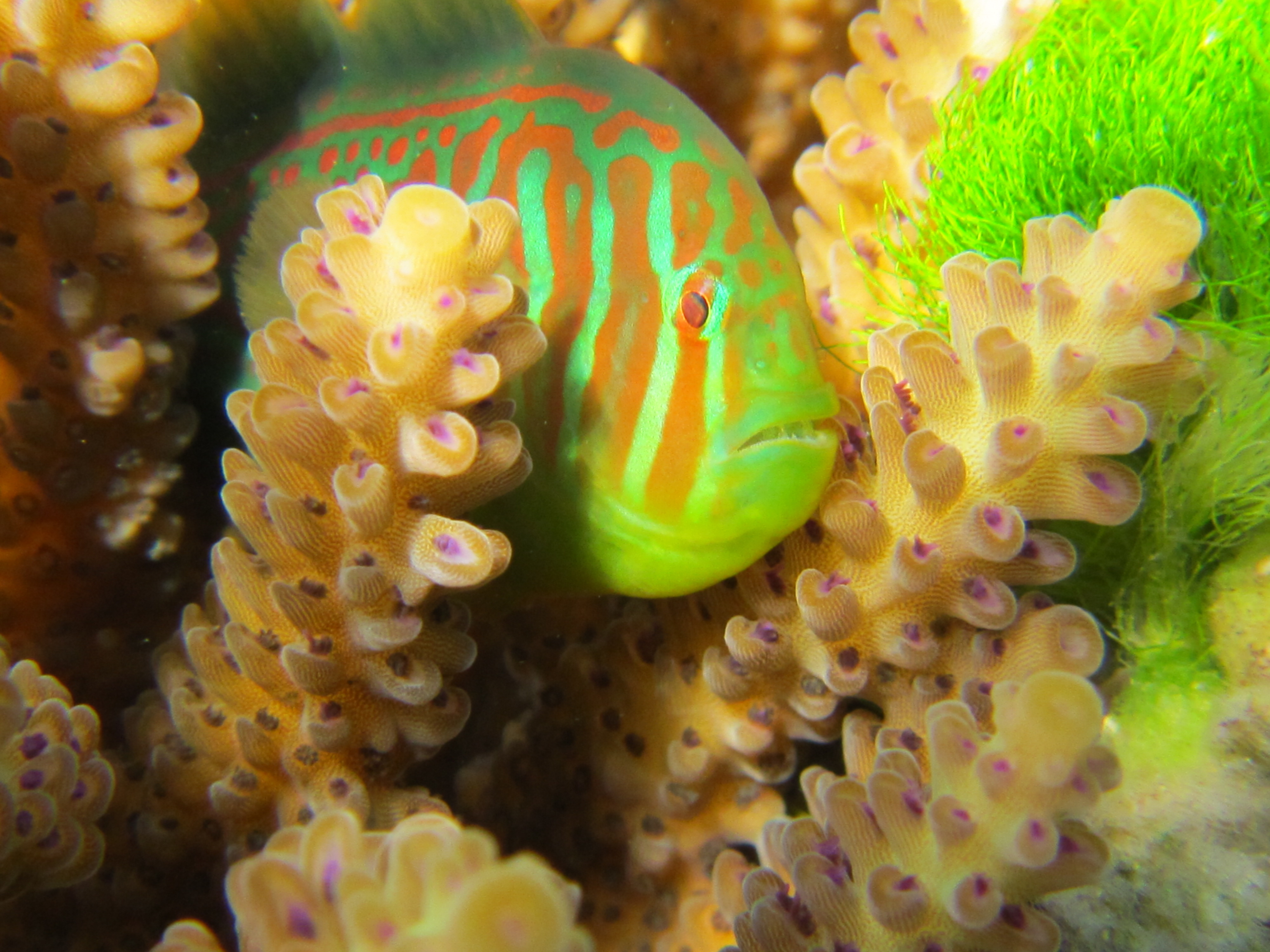
Goby fish on a coral reef in Fiji; green algae are moving in on the coral, but gobies rescue.
Credit: Danielle Dixson
Credit and Larger Version
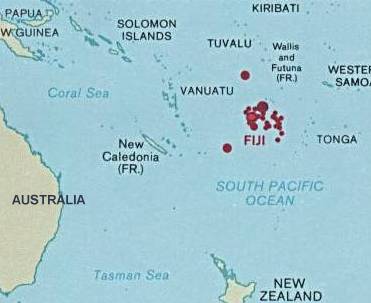
Scene of the crime: Fiji and its coral reefs in a vast ocean.
Credit: Wikimedia Commons
Download the high-resolution JPG version of the image. (16 KB)
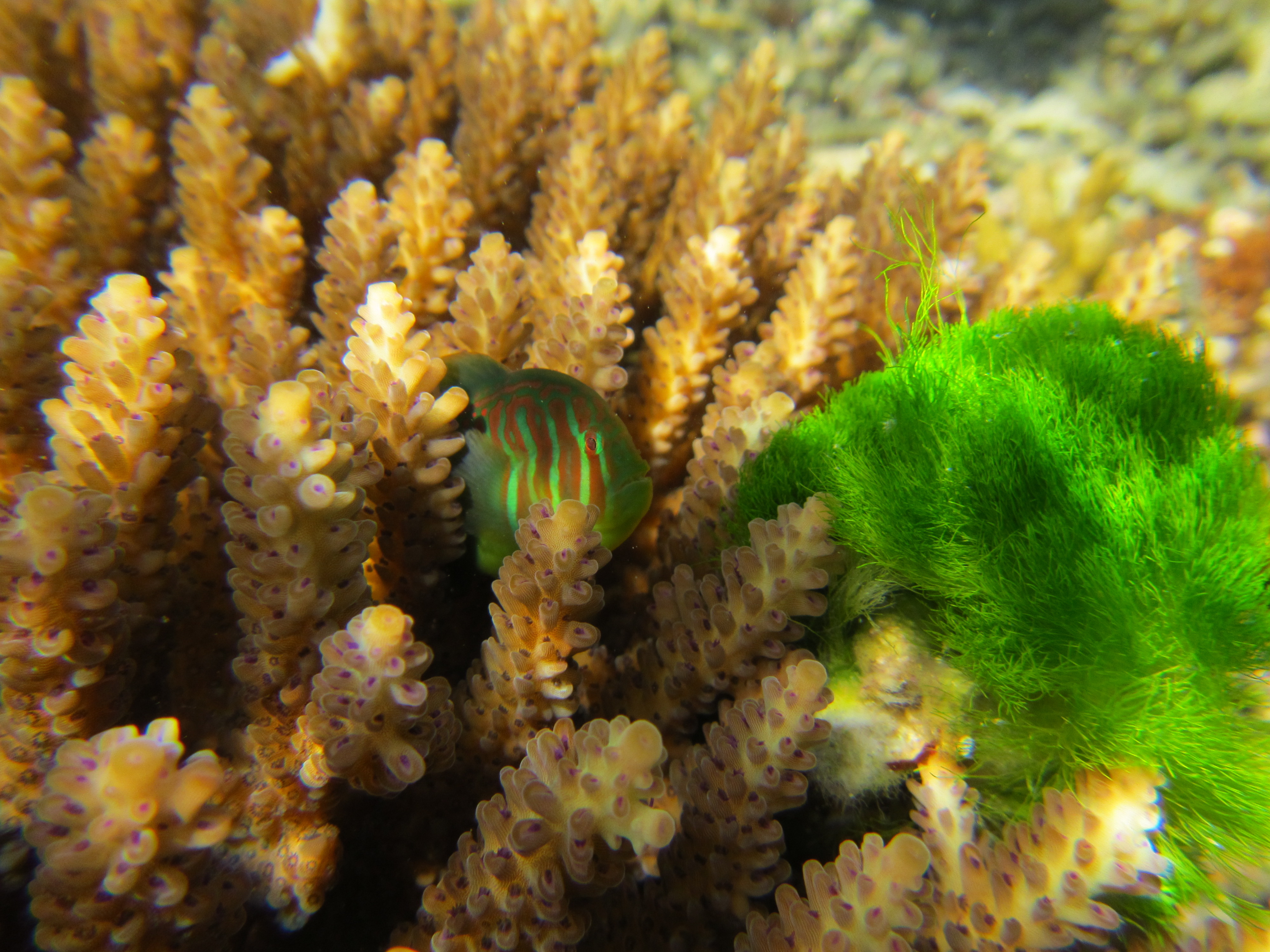
A goby on-the-job: it's feeding on algae that would otherwise cover the coral.
Credit: Danielle Dixson
Download the high-resolution JPG version of the image. (2.7 MB)
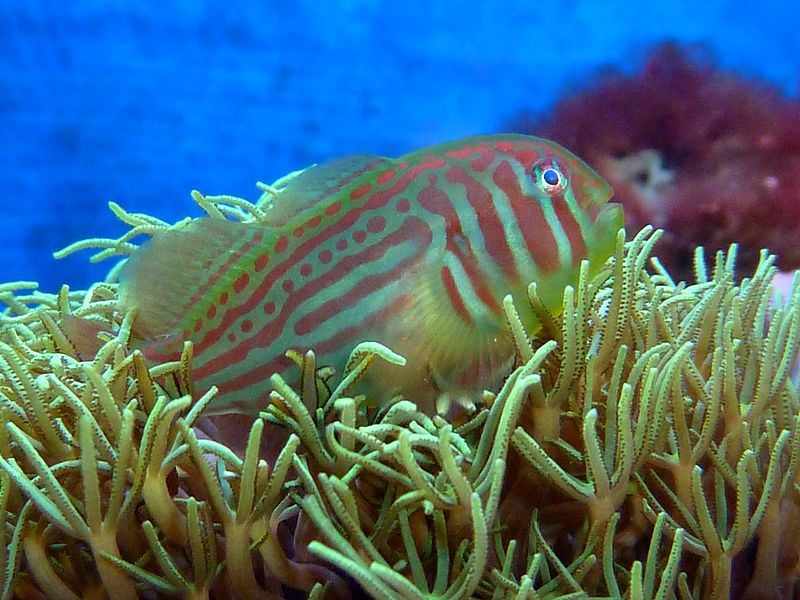
Goby fish in the genus Gobiodon: the fish are common coral reef residents in Fiji.
Credit: Wikimedia Commons
Download the high-resolution JPG version of the image. (101 KB)
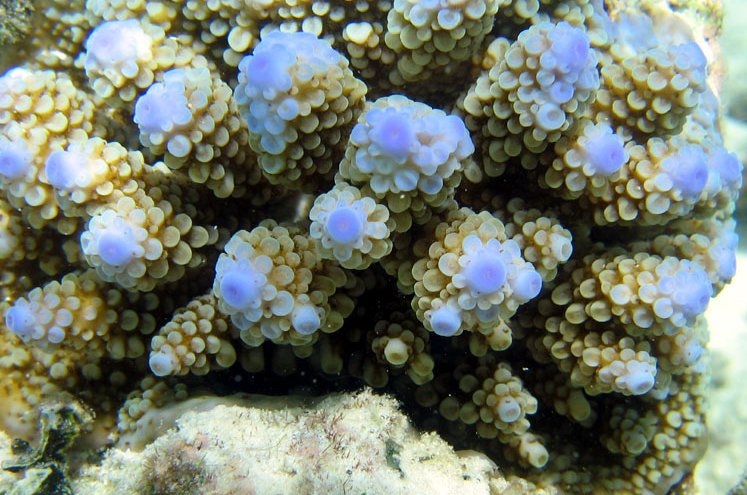
Close-up of Acropora coral: it "calls 911" when it chemically senses certain algae.
Credit: Wikimedia Commons
Download the high-resolution JPG version of the image. (113 KB)

The research results are described in the Nov. 9, 2012 issue of the journal Science.
Credit: AAAS Copyright 2012
Download the high-resolution JPG version of the image. (382 KB)
Corals under attack by toxic seaweed do what anyone might when threatened--they call for help.
Results reported this week in the journal Science
show that threatened corals send signals to fish "bodyguards" that
quickly respond to trim back noxious algae, which can kill the coral if
not promptly removed.
Scientists at the Georgia Institute of
Technology found evidence that these "mutualistic" fish respond to
chemical signals from the coral in a matter of minutes, like a 911
emergency call.
The inch-long fish--known as gobies--spend their
entire lives in the crevices of specific corals, receiving protection
from their own predators while removing threats to the corals.
"These
findings illustrate the complexity of coral reef systems," said David
Garrison, program director in the National Science Foundation's Division
of Ocean Sciences, which funded the research. "This newly discovered
relationship may be a key factor in the resilience of some coral
species."
The symbiotic relationship between fish and the coral on
which they live is the first known example of one species chemically
signaling a consumer species to remove competitors.
It is similar to the symbiotic relationship between Acacia
trees and mutualist ants, in which the ants receive food and shelter
while protecting the trees from both competitors and consumers.
"This
species of coral is recruiting inch-long bodyguards," said Mark Hay, a
biologist at Georgia Tech and co-author of the paper. "There is a
careful and nuanced dance of odors that makes all this happen.
"The fish have evolved to cue on the odor released into the water by the coral, and they very quickly take care of the problem."
The
research was part of a long-term study of chemical signaling on Fiji
Island coral reefs. It was aimed at understanding these threatened
ecosystems and discovering chemicals that may be useful as
pharmaceuticals.
The importance of large herbivorous fish to
maintaining the health of coral reefs has been known for some time.
They control the growth of seaweeds that damage coral.
But Georgia
Tech scientist Danielle Dixson, also a co-author of the paper,
suspected that the role of the gobies might be more complicated.
To
study that relationship, she and Hay set up a series of experiments to
observe how the fish would respond when the coral that shelters them was
threatened.
They studied Acropora nasuta, a species in a
genus of coral important to reef ecosystems because it grows rapidly
and provides much of the structure for reefs.
To threaten the coral, they moved filaments of Chlorodesmis fastigiata, a species of seaweed that is particularly chemically toxic to corals, into contact with the coral.
Within a few minutes of the seaweed touching the coral, two species of gobies--Gobidon histrio and Paragobidon enchinocephalus--moved toward the site of contact and began neatly trimming away the offending seaweed.
"These little fish would come out and mow the seaweed off so it didn't touch the coral," said Hay.
"This
takes place very rapidly, which means it must be very important to both
the coral and the fish. The coral releases a chemical and the fish
respond right away."
In corals occupied by the gobies, the amount
of offending seaweed declined 30 percent over a three-day period, and
the amount of damage to the coral declined by 70 to 80 percent.
Control corals that had no gobies living with them had no change in the amount of toxic seaweed and were badly damaged by it.
To
determine what was attracting the fish, Dixson and Hay collected
samples of water from several locations: near the seaweed itself where
the seaweed was contacting coral and from coral that had been in contact
with the seaweed 20 minutes after the seaweed was removed.
They
released the samples near other corals that hosted gobies, which were
attracted to the samples taken from the seaweed-coral contact area and
the damaged coral, but not the seaweed by itself.
"We demonstrated
that the coral is emitting some signal or cue that attracts the fish to
remove the encroaching seaweed," Hay said. "The fish are not responding
to the seaweed itself."
Similar waters collected from a different
species of coral placed in contact with the seaweed did not attract the
fish, suggesting they were only interested in removing seaweed from
their host coral.
Finally, the researchers obtained the chemical
extract of the toxic seaweed and placed it onto nylon filaments designed
to simulate the mechanical effects of seaweed.
They also created simulated seaweed samples without the toxic extract.
When
placed in contact with the coral, the fish were attracted to areas in
which the chemical-containing mimic contacted the coral, but not to the
area contacting the mimic without the chemical.
By studying the contents of the fish digestive systems, the researchers learned that one species--Gobion histrio-- actually eats the noxious seaweed, while the other fish apparently bites it off without eating it.
In the former, consuming the toxic seaweed makes the fish less attractive to predators.
The
two species of fish also eat mucus from the coral, as well as algae
from the coral base and zooplankton from the water column. By defending
the corals, the gobies are defending the home in which they shelter and
feed.
"The fish are getting protection in a safe place to live
and food from the coral," Hay said. "The coral gets a bodyguard in
exchange for a small amount of food.
"It's kind of like paying taxes in exchange for police protection."
As a next step, Hay and Dixson plan to determine whether other species of corals and fish have similar symbiotic relationships.
The research was also supported by the National Institutes of Health and the Teasley Endowment at Georgia Tech.
-NSF-
Media Contacts
Cheryl Dybas, NSF (703) 292-7734 cdybas@nsf.gov
John Toon, Georgia Tech (404) 894-6986 john.toon@innovate.gatech.edu
John Toon, Georgia Tech (404) 894-6986 john.toon@innovate.gatech.edu
The National Science Foundation (NSF) is an independent federal
agency that supports fundamental research and education across all
fields of science and engineering. In fiscal year (FY) 2012, its budget
is $7.0 billion. NSF funds reach all 50 states through grants to nearly
2,000 colleges, universities and other institutions. Each year, NSF
receives over 50,000 competitive requests for funding, and makes about
11,000 new funding awards. NSF also awards nearly $420 million in
professional and service contracts yearly.
Useful NSF Web Sites:
NSF Home Page: http://www.nsf.gov
NSF News: http://www.nsf.gov/news/
For the News Media: http://www.nsf.gov/news/newsroom.jsp
Science and Engineering Statistics: http://www.nsf.gov/statistics/
Awards Searches: http://www.nsf.gov/awardsearch/
NSF Home Page: http://www.nsf.gov
NSF News: http://www.nsf.gov/news/
For the News Media: http://www.nsf.gov/news/newsroom.jsp
Science and Engineering Statistics: http://www.nsf.gov/statistics/
Awards Searches: http://www.nsf.gov/awardsearch/
The National Science Foundation (NSF)
Guillermo Gonzalo Sánchez Achutegui
ayabaca@gmail.com
ayabaca@hotmail.com
ayabaca@yahoo.com

No hay comentarios:
Publicar un comentario